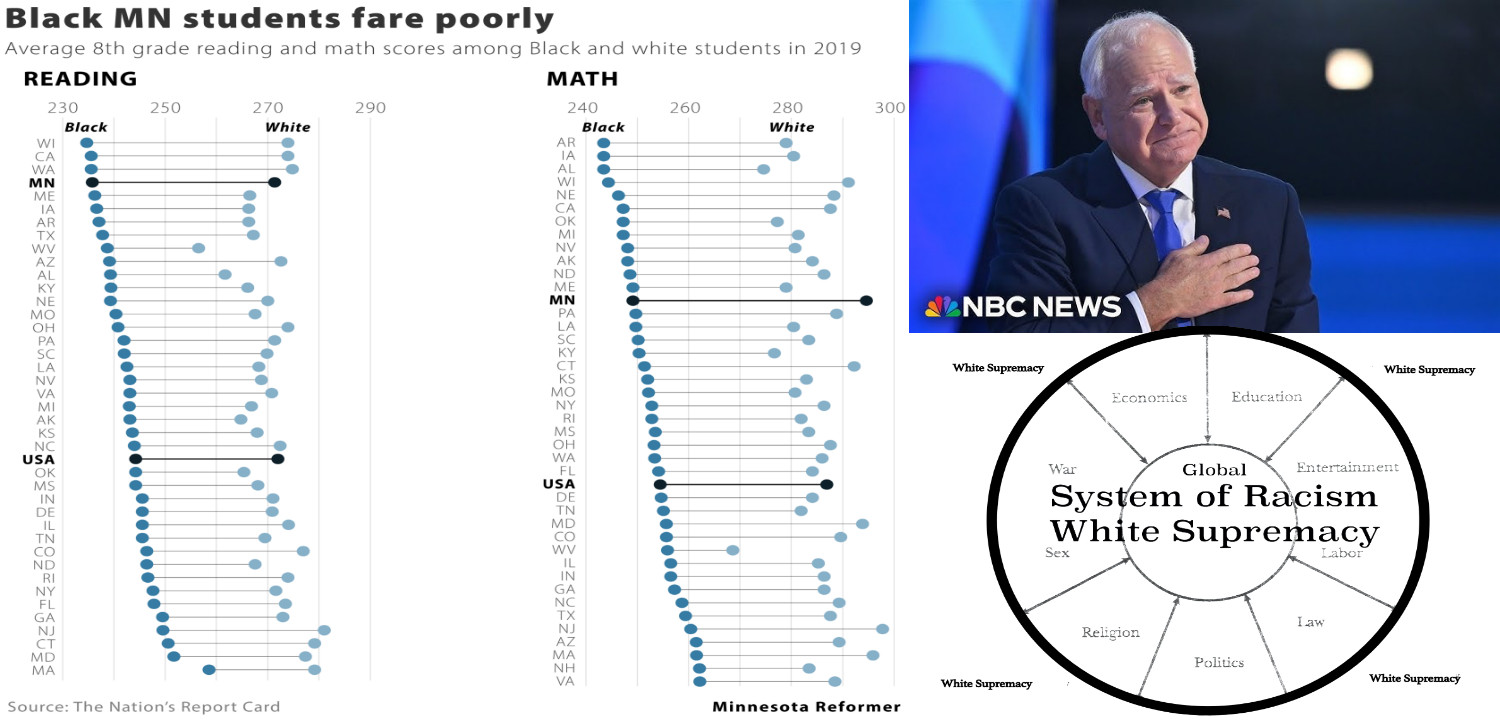Tim Walz says ‘Never Underestimate a Public School Teacher,’ Yet the MN Public Fool System is Among the Worst in the US for Non-White Children. Blacks Kids Have the 4th Lowest Reading Scores (CA 2nd)
/MINNESOTA SCHOOLS ARE GOOD FOR RICH WHITE CHILDREN. NOT BLACK, LATINO, NATIVE OR POOR WHITE KIDS.
According to the Federal Reserve Bank of Minneapolis, “Some of Minnesota’s educational disparities are among the worst in the nation (Grunewald and Nath 2019); White children generally perform better than their national peers, while Native American children and children of color perform worse. After elementary school children enter high school, Native American children and children of color are less likely to graduate, or to have access to important opportunities like dual enrollment in top-tier institutions of higher learning (Minnesota’s Statewide Longitudinal Education Data System, or SLEDS, no date; Trost 2016).”
Minnesota often ranks among the top states in terms of standardized test scores and college readiness (Grunewald and Nath 2019). But this ranking obscures Minnesota’s large achievement gaps by race and ethnicity. These disparities are among the largest in the nation, and show no signs of diminishing. [MORE]
The data show Minnesota’s racial gaps in education are stark and among the worst in the county. According to the Minnesota Department of Education About 31% of Black students met or exceeded grade level standards in reading, compared to 58% of white students. About 21% of Black students were proficient in math, while 55% of white students met grade level standards.
About 24% of Hispanic or Latino students were proficient in math and 31% met reading standards. About 32% of American Indian students were proficient in reading and 24% in math. [MORE]
FAKE MF. Tim Walz in acceptance speech: 'Never underestimate a public school teacher'
NEELY FULLER EXPLAINS THAT RACISM IS PRIMARILY CARRIED OUT BY DECEPTION AND THAT ELITE RACISTS ARE MASTERFUL LIARS. THEY HAVE BEEN ABLE TO TRICK GULLIBLE BLACK PEOPLE FOR CENTURIES. AS SUCH, BLACK PEOPLE REMAIN IN A CONTINUOUS STATE OF CHECKMATE. For example, He states, “ELITE RACISTS, pretend to provide economic progress while working to hinder it, pretend to to provide educational progress while working to hinder it and Pretend to promote justice, while working to continue, and refine, the practice of injustice.’ [MORE]
ACCORDING TO FUNKTIONARY:
public schools – the instrument of Hidalgo (the “Greater System”) and the Corporate “State” whereby readers, writers and counters are produced and certified as qualified to understand orders and obediently carry them out… the tenth gang-plank of the Communist Manifesto. (See: Compulsory Schooling, Indoctrination, Authority & Formal Education)
Public School System – a place where children are having unprotected education. 2) a syndromatic exercise in conformity and blind obedience to so-called “authority” (disguised repression). 3) systematic planned violence meted out on children and young adults—held hostage and hostile—daily, hourly, quarantined from the natural rhythm of things in life through Pavlovian bells and shrink-wrapped prefabricated and curriculum and distorted history. 4) a training boot camp for life-long slavery and indentured servitude to gangbankers and the Corporate State in a society created and based in violence, governed by fear, propaganda, psychogenic money and power.
BLACK KIDS DOING WORSE IN MINNESOTA. Students of color, especially Black students, are not doing better than other states; they are actually testing lower than the majority. According to statistics compiled by the U.S. Department of Education, Black students in Minnesota tend to fare poorly both relative to Black students in other states, as well as to in-state white pupils.
In 2019, for instance, Minnesota posted the fourth-lowest reading test scores among the nation’s Black eighth graders. The state’s white eighth-graders, by contrast, were in the middle of the pack. Overall, the gap between the two was the fourth worst in the nation.
On math, Minnesota’s Black eighth-graders fared slightly better, coming in at 13th nationwide. But white students did even better, coming in at 3rd in the nation. All told, the math gap between the two was the second worst in the nation, behind only Wisconsin.
The picture for Minnesota’s fourth-graders is somewhat different. There, according to federal data, Black and white students rate close to average for both reading and math. But achievement gaps remain, with white students faring better. [MORE]
LESS RESOURCES FOR NON-WHITE SCHOOLS. Schools serving Native American students and students of color often have fewer resources to offer their students. For example, Minnesota data show that Native American students and students of color tend to attend schools with less-experienced teachers (Grunewald and Nath 2019). Without the resources necessary to recruit and retain teachers, schools that serve more students of color are at a disadvantage.[MORE]
ONLY WHITE TEACHERS ALLOWED. Between 2008 and 2018, the proportion of students of color rose from 24 percent to 34 percent across Minnesota’s public schools, but the proportion of teachers of color remained constant at around 5 percent (Star Tribune 2018).
NOT PREPARED & LESS LIKELY TO FINISH COLLEGE. Native American, Black, and Latino/a students are less likely to attend college than White students and are also less likely to finish when they do attend. Among Minnesota’s high school graduating class of 2016 who enrolled in college, 38 percent of Native American students, 51 percent of Latino/a students, and 52 percent of Black students remained enrolled in their fourth academic year, compared to 68 percent of Asian students and 71 percent of White students (SLEDS n.d.). Similarly, among 2008 college entrants nationwide, only 41 percent of Black students and 53 percent of Latino/a students completed their degree within six years, compared to 63 percent of White students (Deming 2017). [MORE]







































































































































































































































































